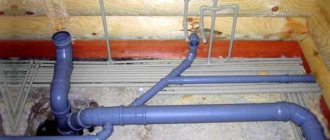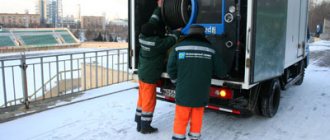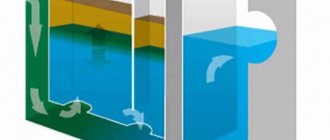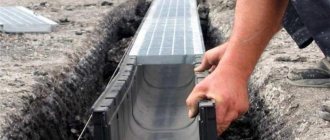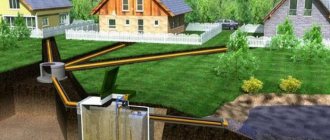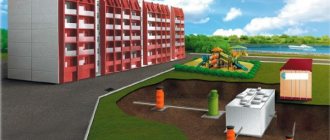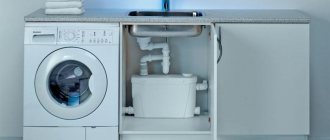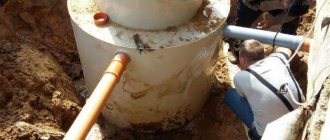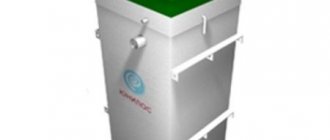A conscientious owner of a country plot, a master in all the positive senses of the word, will think through every detail during construction. This includes organizing the drainage of water falling with precipitation or formed during the massive spring melting of snow. In other words, he will not forget about a reliable, professionally designed and high-quality installed storm sewer system. Only in this case can you not be afraid that the area around the house will turn into a swamp after each rain.
Storm drain cleaning technology
But even the presence of a storm drain does not always guarantee the absence of negative consequences after heavy rain or melting snow. No matter how high-quality the system is, contaminants carried by masses of water can gradually settle in gutters and pipes and clog filtering devices. Even small blockages can significantly complicate the timely drainage of water. Well, if somewhere, especially in an underground highway, a dense traffic jam forms - good for you. The entire stormwater system may become inoperable.
This means that in such cases, emergency restoration measures must be taken. And it will be very great if the owners have mastered the technology of cleaning storm drains well, and all the equipment and tools necessary for this purpose are stored in the workshop or storeroom.
Description of storm drainage
Storm drainage refers to the peripheral sewerage system of residential areas and operational lands. The quality of not only the site itself, but also the premises operated on it directly depends on the quality of the storm drainage.
Storm drainage looks like this: first of all, precipitation flows into special trays and goes along linear drainage gutters. The mechanism for collecting snow and rainwater is very similar to a pipeline system inside the soil that transports precipitation into a tunnel or special well.
To keep the wells clean and not clogged, nets are installed between them and the storage gutters to collect debris that may fall into the gutters during operation. They are called sand traps.
Drainage pipes installed along the drainage system allow you to cope with excess precipitation, and through the hatches it is convenient to monitor and check how the storm drain works.
The benefits of installing a well-planned sediment drainage system on your site will help:
- extend the service life of paving stones;
- maintain the shape of the paths;
- prevent erosion of roads leading to the site;
- avoid deformation of the foundation of utility and residential premises;
- prevent soil waterlogging, preserve current flora;
- prevent soil from sliding;
- enjoy the pristine beauty of the buildings for as long as possible.
It is necessary to take into account the materials from which the components of the system are made, then it will be possible to accurately understand the characteristics of the sewer system and its disadvantages. Knowing these points and understanding exactly how the storm drain should be operated, it is easy to extend its service life and improve the quality and reliability of its operation.
Causes of clogged storm drains
With proper operation, storm drainage will perform its function for quite a long time. If you do not care for and monitor the system, there is a possibility of clogged drains, which will lead to interruptions in operation. The water simply won’t drain as expected, it will begin to stagnate in the gutters and fade away. Storm drains of any design require maintenance, regardless of the type of materials or type of system.
What points need to be taken into account when servicing storm drains, and what should be avoided:
- The more water that enters the drain, the more debris it can drag with it, so you need to pay special attention to cleaning sand traps during the rainy season, for example, in the spring.
- Please note that insects, sand, leaves, and mown grass periodically get into the pipes.
- When installing, ask the installers if they are aware of the SNiP requirements. The sewerage design has fairly clear standards that provide for the transportation of water from the site to the well. For example, water supply gutters should have a slope of 2 to 7 mm towards storage reservoirs. If the slope is made smaller, the water speed will be too low and the debris will be distributed along the main line. If the pipes are inclined too much, the water speed will not allow heavy dirt to be picked up.
- Avoid a lot of rotations when designing the structure. Small debris will collect in the bends of the pipes and form regular blockages.
- You should not connect the house and storm sewer systems. Grease and debris from the house will create a very dense plug that will need to be constantly searched for and broken - not the most pleasant task, considering what usually ends up in the home drain.
- Lots of sharp bends. Debris will accumulate around corners.
- When carrying out repair and construction work, check drains and storm sewer pipes. Cement sand, sawdust, polystyrene foam, packaging polyethylene, etc. can stagnate in the trays.
With unscrupulous cleaning and poor quality maintenance of storm sewer systems, there is a risk that a large amount of water will lead to the following:
- Erosion and deformation of the foundation of buildings located on the site.
- Making a cellar or basement unusable due to excessive dampness or complete flooding.
- Waterlogging of the area, as a result, death of plants.
- The accumulation of debris and dirt on the roof can put too much stress on the roofing fasteners and cause the structure to collapse.
- If water overflows the edge of your gutters and runs down your walls, it can cause dampness, musty odors, and mold in your home.
Signs and dangers of blockage
The main sign of clogged storm drains is flooding of the site and the house. Even partially clogged communications are not able to remove water during heavy rain or intense snow melting. If the storm drain is completely clogged, then in bad weather expect water standing in puddles at the locations of the receiving wells.
A one-time flood on the site can pass without leaving a trace. However, repeated episodes of stagnation of the effects of precipitation are fraught with:
- destruction of the foundation of the house and buildings;
- flooding of basements or subfloors;
- the development of fungal infections of structural elements of the building, and not only wooden ones;
- soaking of plants on the site;
- development of rotting processes on a personal plot, local area;
- death of cultivated plants on the territory;
- deterioration of the aesthetics of the site and buildings.
Note! The processes described above are developing slowly but inevitably. Preventative cleaning of storm drains will cost much less than repairing a house or reconstructing a site.
Types of storm drainage
When installing storm drains, you may be faced with the problem of choice - the types of devices vary in type of design, materials used, required maintenance and its regularity.
There is a variant of an open design, the so-called external sewer. It consists of specialized trays for collecting water, which are installed around the perimeter of the roof and provide a system for discharging waste further through pipes. In the ground, almost at the surface, there are also drainage trays with protective gratings, from which precipitation flows further into the drainage system. This is a relatively simple design to install and manufacture, but it performs its function well – draining excess water from the site.
Pipe cleaners: choosing the best method
More details
The second version of the system is a closed structure. It is more complex than an open sewer. This is already a system of underground engineering structures, providing underground wells and a cleaning system. It usually comes to the surface with drain cleaners.
Typically, closed storm drains are installed in areas where there is a need to purify rain and melt water from small and household debris.
There is a third option - a mixed type system. There are both open trays, which are responsible for collecting precipitation, and closed pipes, which transport water to the sewer networks.
Types of storm drains
Cleaning methods and frequency depend on the type of sewage system in the area.
Types of storm drains
Open or linear
It consists of gutters slightly deepened into the ground along the paths. The top of the gutters is covered with a grill. Although such a sewer gets clogged more often, it is also much easier to clean.
You just need to remove the grates and mechanically remove the accumulated dirt. For example, a broom, shovel or dustpan.
Linear storm drain
Cleaning should begin from top to bottom so as not to do the job twice. The first step is to remove leaves from roofs and drainpipes, and then clean the trays on the ground.
For better results, you can rinse everything under running water. At the end of the work, all the gratings are installed in their places.
Closed or deep
The pipes in such a sewer system are underground, and only rainwater inlets covered with gratings are brought to the surface. All water from the deep storm drainage flows through the storm well into the collector.
Closed storm sewer system
For preventive maintenance, you need to remove and wash the grating of the rain inlets from time to time, as well as clean the sand catcher baskets. If a deeper cleaning is required, there may be several options:
- Hydrodynamic cleaning.
- Mechanical.
- Thermal.
- Chemical.
Have you decided to organize a rainwater drainage system? Then it will be useful for you to know how to choose pipes for storm drainage. Let's look at different materials and learn how to choose the right pipe diameter. Read about how to clean a sewer in a private home here. Methods of combating and preventing blockages.
And here https://aquacomm.ru/cancliz/zagorodnyie-doma/avtonomnaya/livnevaya/ustroystvo-livnevoy-kanalizatsii-neobhodimaya-proektnaya-dokumentatsiya-i-soglasovaniya.html all about the documentary component when creating a storm sewer. Necessary design documentation and approvals.
Hydrodynamic cleaning
The most convenient and common way to deal with debris in storm drains is hydrodynamic. Moreover, this method is used by both private owners and specialists.
The operating principle is the same: supply water into the pipes under strong pressure. Only private owners use a regular watering hose for this purpose, while professionals use large equipment with a pressure of 120 atmospheres or more (silt suckers and sewer washing machines).
The principle of hydrodynamic sewer cleaning
It makes sense to use heavy equipment for large storm sewer systems. If the diameter of the pipes is a meter and the length is 100 m, it is absolutely clear that one person cannot cope with this. Organizations need to plan the involvement of such equipment at the stage of storm sewer design. The machines are bulky and heavy. Flushing a large system with removal of sand and water can take an entire work shift, or even two.
You need to think about:
- Where will the cars be parked and will they block the roadway?
- Take care of the flooring if it is possible for it to sink into the ground;
- Where will they get water from, is there a hydrant nearby, for example;
- Where will the water and sludge be disposed of (whether it will be transported or drained to a site for drying and subsequent disposal).
Storm drain cleaning technology
If the storm drain is not so large (pipe diameter is about 200 mm), they resort to using a car wash. It is compact, it can be used where cars cannot pass, while the operating pressure is 350 bar and the productivity is 1250 l/h.
In all other cases, the owner can handle the flushing himself, using, for example, a watering hose and a drainage pump.
If there are small blockages in the system, it is better to do flushing on both sides: at the outlet and at the inlet. Any other method of cleaning a storm drain ends with hydrodynamic cleaning.
Mechanical
You can get to the blockage underground using a special cable.
The cable may have attachments. If they are not there, you can soak the end of the cable that was soldered from the factory.
The order of work is as follows:
- Remove the grill;
- Twist the cable and, holding it with one hand, lower the end into the pipe;
- Having reached the place of the blockage, turn the cable handle;
- If the blockage is severe, you may need to pull out the cable and wash it.
Pipe cleaning cable with attachment
When working with a cable, always turn the handle in one direction so as not to damage either the pipes or the structure of the cable.
The purpose of working with a cable is not to push the clog deeper, but to break it up and soften it in the pipe so that in the future you can wash out the debris with a stream of water.
Thermal method
This is essentially the same hydrodynamic method, but washing is done with hot water. Steam can also be used.
Such cleaning may be necessary if the pipes are heavily contaminated, when a regular stream of water cannot cope. For example, if in some area, storm and internal sewerage are combined into one, grease may settle on the pipes.
Sewer pipe before and after hydrodynamic hermetic cleaning
For thermal cleaning, water is overheated to 120°C.
The work is carried out using a high-pressure apparatus for thermal cleaning. The equipment is expensive, so it is not possible to use it in every case.
Chemical
In rare cases, when the blockages have already turned into a solid state, they resort to the help of chemistry.
Surfactants soften contaminants accumulated in pipes.
Such washing is carried out only by professionals using special equipment.
The reagents are fed into the pipes in foamed form under high pressure. After chemicals, the system is washed with clean water.
When using chemicals:
- You need to protect your hands with gloves and your respiratory tract with a mask;
- Cleaning is accompanied by specific odors;
- The environment is harmed;
- The service life of the sewer system is reduced.
In this case, the price of reagents is added to the cost of workers’ services, so the method turns out to be very expensive.
The costs of routine flushing of storm drains cannot be compared with the cost of emergency work using heavy machinery and expensive equipment. Without allowing a careless attitude towards storm drainage, you don’t have to worry about the condition of buildings, paths and lawns, which it protects from rain.
A drainage pump for sewage is simply necessary for a private home if there is no possibility of centralized disposal of waste water. How to choose a fecal pump for sewage? Types of pumps and their design. Read about PVC pipes for external sewerage in this article.
Features of storm sewer maintenance
Stormwater pipes are cleaned hydraulically, i.e. huge pressure of water. People usually call a professional to perform storm drain maintenance.
Stores for summer cottages offer for sale mini-equipment for home use - a device with less power than an industrial one, but quite suitable for cleaning the area yourself. The equipment is, on the one hand, a pump that is connected to a water source (reservoir, well, water supply system), and on the other, a hose that is inserted into the cleaning area. Accordingly, the pump turns on, water under pressure flows through the hose into the pipe, and under water pressure the debris comes out of the cleaning system.
The purification process is monitored through special wells. They are installed in places of potential problems - at pipe joints or bends, or every 50 meters to a depth of no more than half a meter. It makes no sense to make inspection wells deeper because... Storm drainage is installed shallow. Therefore, the hoses included with the cleaning equipment are up to 6 m long.
Cleaning the sewer is not a difficult task, but it is labor-intensive. In order to carry it out as little as possible when necessary, you should, firstly, install the system in accordance with the requirements of SNiP and using related equipment (grids, sand traps, wells, etc.), and secondly, periodically manually remove debris that accumulates on gratings and on pipe bends.
Self-cleaning
The simplest method of cleaning storm drains, accessible to an amateur, is mechanical, for cleaning an open atmospheric water drainage system. Mechanical cleaning of storm drains here refers to the removal of contaminants from gutters, channels, trays, and grates manually. In this case, available tools are used: scrapers, brushes, pipe cleaners, shovels. The final stage of manual cleaning is flushing the channels with water pressure from a hose.
We recommend that you read: How to determine to what depth and at what slope a sewer pipe can be buried?
To wash small diameter pipes, up to 20 cm in diameter, you can use a Karcher car wash. With its help, it is convenient to remove contaminants from storm drains after heavy rains, when there is no traffic jam yet, but its formation is more than possible.
Methods for cleaning storm drains
The most popular ways to clean storm drains are:
- Mechanical - a method that does not require additional equipment or skills. Branches, leaves and other debris are collected manually or with a spatula. Suitable for all types of systems.
- Hydrodynamic is a method that we have discussed in detail. A strong water pressure is created using a pump and, under pressure, debris and dirt are knocked out of the pipe.
- Thermal - a method similar in its action to the previous one, the difference is that the water is heated either to a hot temperature or to the state of steam.
- Chemical - usually used in closed systems, but extremely rarely, only if previous methods did not help. Special solutions are introduced into the sewer system and dissolve debris or plugs in hard-to-reach places. It is used extremely rarely, because the composition of cleaning products is unsafe for the environment.
Which way is better
The choice of treatment technology is determined by the degree of contamination and the area of drainage systems.
For open home structures, the mechanical method in combination with drainage is sufficient.
In utility networks and industrial areas, where a lot of waste gasoline, oil, other petroleum products and construction waste accumulate, large volumes of pollution accumulate, special equipment is used, chemical and thermal methods are used.
Obviously, the best result will be achieved by a simultaneous combination of all cleaning methods.
Frequency of flushing storm drains
With proper design, installation and operation of a storm drain, the system must be designed in such a way that it cleans itself.
Nevertheless, there is always a possibility that small leaves, insects, and grains of soil will settle on the walls of the system and impair the conductivity of the pipes.
How to clear a clog with a cable: step-by-step algorithm
More details
Stopping the functioning of the sewer system for its intended purpose leads to disastrous consequences, ranging from washed-out paths to a flooded cellar and fungus on the walls. In order not to encounter such problems, they should be prevented - thoroughly inspect the entire system for deterioration in water conductivity, debris settling on the walls or blocking of grates with sand. This should be done at least once a year, and preferably once a season.
You should especially remember about the technical inspection of drainage pipes during periods that are dangerous for storm drains - in the spring, when the snow melts and melt water flows into hatches in large volumes, and before winter, when weather forecasters promise a lot of prolonged rain.
If you know that repair and construction work is being carried out on your site or there was a holiday after which a lot of water-insoluble waste remained, it is worth carrying out an unscheduled inspection and cleaning.
How often to carry out cleaning work
It is important to clean storm drains in a timely manner. Gutters are cleaned twice in the spring:
- Before the snow melts, remove ice dams so that melt water can drain freely from the roof;
- after the snow melts, they clear away the sand, dirt and branches that have accumulated in its layers.
During the same period, other elements of the storm drain are checked and cleaned.
In autumn, the system becomes clogged with fallen leaves, summer dust and rain mud. It is necessary to get rid of them before the first frost, otherwise they will cause the formation of ice, which can lead to freezing of drainage pipes and their rupture in winter.
The presented video shows the cleaning of an external rainwater drainage well
